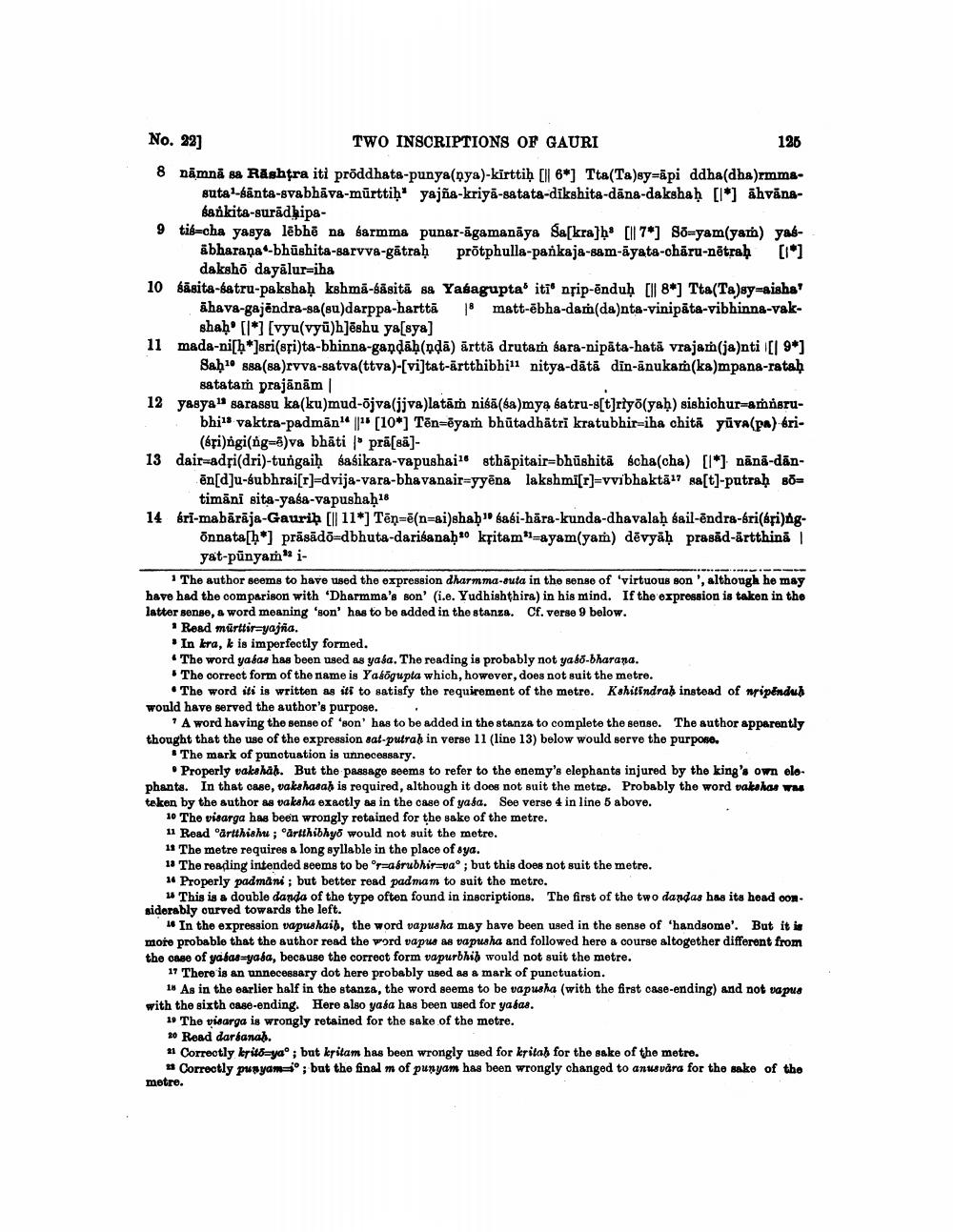________________
No. 22] TWO INSCRIPTIONS OF GAURI
126 8 nämnā sa Rashtra iti pröddhata-punya(nya)-kirttiḥ (Il 6*) Tta(Ta)sy=āpi ddha(dha)rmma
suta-santa-svabhāva-mūrttiḥ' yajña-kriya-satata-dikshita-dana-dakshaḥ [l*] āhvāns
bankita-suradhipa9 tis-cha yagya lebho na barmma punar-āgamaniya Sa[kra]h[ll 7*] 88-yam(yan) yas
abharaṇa'-bhūshita-sarvva-gātraḥ prātphulla-pankaja-sam-āyata-chāru-nētraḥ [1*]
dakshō dayālur=iha 10 sāsita-satru-pakshaḥ kshmā sāsitā sa Yasagupta itī® nsip-ēnduḥ [ll 8*] Tta(Ta)sy-aisha'
ähava-gajēndra-sa (su)darppa-harttā matt-ēbha-dam(da)nta-vinipāta-vibhinna-vak
shah. [l*] [vyu(vyū)h]ēshu ya[sya] 11 mada-ni[h*]sri(spi)ta-bhinna-gandāḥ(pdā) ārttā drutan bara-nipäta-hatā vrajam(ja)nti [1 9*]
Saho ssa (sa)rvva-satva(ttva)-[vi]tat-artthibbini nitya-dātă din-anukam(ka)mpana-rataḥ
satatam prajānām 12 yasya " sarassu ka (ku)mud-õjva(jjva)latām nisā (sa)mya satru-s[t]rtyõ(yah) sishichur=amisru
bhi vaktra-padman" || [10*] Tēn=ēyam bhūtadhātri kratubhir=iha chita yūra(pa) bri
(eri)igi(ng=)va bhāti | prā[sā]13 dair=adri(dri)-tungaiḥ sasikara-vapushai" sthāpitair=bhūshitā écha(cha) [1*] nānā-dān
ēn[d]u-subhrai[r]=dvija-vara-bhavanair=yyēna lakshmi[r]=vvibhaktā? ga[tl-putraḥ sõ=
timäni sita-yasa-vapushaḥ18 14 tri-mabārāja-Gauriḥ [|| 11*] Tēņ=ē(n=ai)shah" sabi-hāra-kunda-dhavalaḥ fail-endra-bri(ári)åg
Õnnata[h*) prāsādā=dbhuta-darisanah ksitam"-ayam(yam) dēvyāḥ prasād-artthina |
yat-pūnyam" i1 The author seems to have used the expression dharmma-suta in the sense of 'virtuous son', although he may have had the comparison with 'Dharmma's son' i.e. Yudhishthira) in his mind. If the expression is taken in the latter sense, a word meaning 'son' has to be added in the stanza. Cf. verse 9 below.
* Read mürttir-yajña.
In kra, k is imperfectly formed. • The word yadas has been used as yala. The reading is probably not ya 68-bharana. . The correct form of the name is Yasögupta which, however, does not suit the metre.
• The word iti is written as its to satisfy the requirement of the metro. Kahitindrah instead of wipenduh would have served the author's purpose. .
A word having the sense of 'son' has to be added in the stanza to complete the sense. The author apparently thought that the use of the expression sat-putrah in verse 11 (line 13) below would serve the purpose.
. The mark of punctuation is unnecessary.
• Properly vakshäb. But the passage seems to refer to the enemy's elephants injured by the king's own elephants. In that case, vakshasa) is required, although it does not suit the metce. Probably the word vakshas mus teken by the author as vaksha exactly as in the case of yasa. See verse 4 in line 5 above.
10 The visarga has been wrongly retained for the sake of the metre. 11 Read "artthiahu ; "artthibhyo would not suit the metre. 11 The metre requires a long syllable in the place of sya. 18 The reading intended seems to be or=aérubhir=vao; but this does not suit the metre. 14 Properly padmani; but better read padnam to suit tho metro.
This is a double danda of the type often found in inscriptions. The first of the two dandas has its head considerably ourved towards the left.
1 In the expression vapushaib, the word vapusha may have been used in the sense of 'handsome'. But it is more probable that the author read the word vapus as vapusha and followed here a course altogether different from the case of yabas yada, because the correct form vapurbhih would not suit the metre.
17 There is an unnecessary dot here probably used as a mark of punctuation.
15 As in the earlier half in the stanza, the word seems to be vapusha (with the first case-ending) and not vapus with the sixth case-ending. Here also yafa has been used for yabas.
1. The visarga is wrongly retained for the sake of the metre. 20 Read darsanal. 21 Correctly krito=yao; but kritam has been wrongly used for krita) for the sake of the metre.
Correctly punyamo; but the final m of punyam has been wrongly changed to anusvåra for the sake of the metre.




